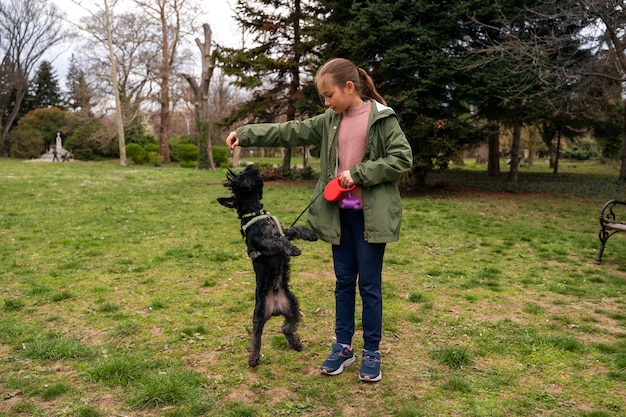Fearful Dogs: Desensitization and Counterconditioning for Confidence

Desensitization and counterconditioning are effective training techniques used to help fearful dogs build confidence by gradually exposing them to anxiety-inducing stimuli while creating positive associations.
Does your dog cower at loud noises, shy away from strangers, or tremble during car rides? You’re not alone. Many dogs struggle with fear and anxiety, but with the right approach, you can help your furry friend build confidence and live a happier, more relaxed life. This article explores fearful dogs: building confidence through desensitization and counterconditioning, offering practical strategies to transform your dog’s fear into courage.
Understanding Fear and Anxiety in Dogs
Before diving into solutions, it’s crucial to understand the root causes of fear and anxiety in dogs. Fear is a natural emotion that helps animals avoid danger, but when it becomes excessive or triggered by harmless stimuli, it can significantly impact a dog’s quality of life. Recognizing the signs is the first step toward helping your dog overcome their fears.
Common Causes of Fear in Dogs
Several factors can contribute to fear and anxiety in dogs, including genetics, early experiences, and socialisation. Some breeds are naturally more predisposed to anxiety, while others may develop fears due to traumatic events or lack of exposure to different environments and stimuli during their critical socialization period.
- Genetics: Some breeds are predisposed to anxiety.
- Early experiences: Traumatic events can cause lasting fear.
- Lack of socialization: Limited exposure to new things during the critical socialization period may cause your dogs to develop phobias.

Recognizing the Signs of Fear and Anxiety
Dogs exhibit fear and anxiety in various ways, and it’s essential to recognize these signs to provide timely support. Common symptoms include trembling, hiding, panting, pacing, excessive barking, and destructive behavior. Some dogs may also exhibit more subtle signs, such as lip licking, yawning, and whale eye (showing the whites of their eyes). Addressing these indicators is critical to manage and alleviate your dog’s distress.
Understanding the causes and recognizing the signs of fear and anxiety are crucial first steps in helping your dog build confidence. By identifying triggers and understanding your dog’s reactions, you can begin to implement strategies to manage their fear and improve their overall well-being.
Desensitization: Gradual Exposure to Fear Triggers
Desensitization involves gradually exposing your dog to fear triggers at a low intensity while ensuring they remain calm and relaxed. The goal is to slowly acclimate your dog to the stimulus without causing anxiety, allowing them to develop a positive or neutral association.
Creating a Hierarchy of Fear Triggers
The first step in desensitization is to identify your dog’s fear triggers and create a hierarchy from least to most intense. For example, if your dog is afraid of thunderstorms, the hierarchy might start with a recording of distant thunder played at a very low volume and gradually increase in volume and intensity over time.
The Desensitization Process
During desensitization sessions, it’s essential to monitor your dog’s body language and ensure they remain below their threshold of fear. If your dog shows any signs of anxiety, such as trembling or panting, reduce the intensity of the stimulus or end the session. The key is to progress slowly and consistently, always prioritizing your dog’s comfort and well-being.
Desensitization is a gradual process that requires patience and consistency. By slowly exposing your dog to fear triggers at a manageable intensity, you can help them develop a positive or neutral association with the stimulus, reducing their anxiety and improving their confidence.
Counterconditioning: Building Positive Associations
Counterconditioning involves changing your dog’s emotional response to a fear trigger by pairing it with something positive, such as treats, praise, or toys. The goal is to create a positive association with the stimulus, replacing the negative emotional response with a positive one. This is an active process that transforms fear into anticipation and excitement.
Pairing Fear Triggers with Positive Reinforcement
During counterconditioning sessions, present the fear trigger at a low intensity and immediately follow it with a positive reinforcement. For example, if your dog is afraid of strangers, have a stranger approach slowly and toss a treat to your dog. Repeat this process multiple times, gradually increasing the proximity of the stranger as your dog becomes more comfortable.
- High-value treats: Use your dog’s favorite treats for maximum impact.
- Positive verbal praise: Offer enthusiastic praise and encouragement.
- Favorite toys: Use toys to redirect your dog’s attention and create a positive association.
The Importance of Timing and Consistency
Timing and consistency are crucial in counterconditioning. The positive reinforcement must be presented immediately after the fear trigger to create a clear association. It’s also important to be consistent with your training and avoid exposing your dog to the fear trigger without pairing it with a positive experience. It will ensure that your dog’s association remains positive every time.

Counterconditioning is a powerful tool for changing your dog’s emotional response to fear triggers. By pairing the stimulus with positive reinforcement, you can help your dog develop a positive association, reducing their anxiety and improving their confidence in the face of frightening situations.
Combining Desensitization and Counterconditioning
Desensitization and counterconditioning are most effective when used together. By gradually exposing your dog to fear triggers at a low intensity while simultaneously pairing them with positive reinforcement, you can create a powerful combination that helps them overcome their fears and build confidence.
Creating a Training Plan
Develop a detailed training plan that outlines the specific fear triggers you’ll be addressing, the steps you’ll take to desensitize your dog to each trigger, and the positive reinforcements you’ll be using for counterconditioning. Be sure to break down each step into small, manageable increments and adjust the plan as needed based on your dog’s progress.
Monitoring Progress and Adjusting the Approach
Continuously monitor your dog’s body language and adjust your approach as needed. If your dog shows any signs of anxiety, reduce the intensity of the stimulus or modify the training plan. Celebrate small victories and remember that progress is not always linear. Patience and understanding are paramount.
By combining desensitization and counterconditioning, you can create a comprehensive approach to addressing your dog’s fears and anxieties. This holistic method builds confidence by minimizing fear triggers while creating positive associations, offering a more effective and lasting transformation.
Managing Setbacks and Maintaining Progress
Setbacks are a natural part of the training process, and it’s essential to be prepared to manage them effectively. If your dog experiences a setback, don’t get discouraged. Simply take a step back in the training plan and revisit earlier steps where they were more comfortable. Adaptability and continued training will support ongoing success.
Recognizing and Addressing Triggers
Identify the specific triggers that caused the setback and adjust your approach to address them more effectively. For example, if your dog became anxious during a thunderstorm, you may need to reduce the volume of the thunder recording or provide additional support and reassurance during the next session.
Maintaining Consistency and Patience
Consistency is key to maintaining progress. Continue to practice desensitization and counterconditioning exercises regularly, even after your dog has made significant progress. Be patient and remember that it takes time for dogs to fully overcome their fears. A long-term strategy will further secure their confidence.
Managing setbacks and maintaining progress require continuous effort and adaptation. By recognizing triggers, adjusting your approach, and staying committed to consistency, you can ensure your dog continues to build confidence and overcome their fears over time.
Seeking Professional Help
In some cases, fear and anxiety may be severe and require professional intervention. If your dog’s fear is significantly impacting their quality of life or if you’re struggling to make progress with desensitization and counterconditioning, consult a certified professional dog trainer or veterinary behaviorist. Their expertise can provide tailored solutions and support.
When to Consult a Professional
Consider seeking professional help if your dog exhibits extreme fear reactions, such as panic attacks or aggression, or if their anxiety is causing them to engage in destructive behaviors. A professional can help you identify underlying issues and develop a comprehensive treatment plan.
- Severe anxiety: If your dog experiences panic attacks, seek help.
- Aggression: If your dog becomes aggressive due to fear.
- Destructive behaviors: If anxiety leads to destructive habits, get professional advice.
Finding a Qualified Trainer or Behaviorist
When searching for a professional, look for certifications and experience in treating fear and anxiety in dogs. Ask about their training methods and ensure they use positive reinforcement techniques. A qualified professional can provide valuable guidance and support to help your dog overcome their fears and live a happier, more relaxed life. They will also tailor a strategy to your pet’s unique needs.
| Key Point | Brief Description |
|---|---|
| 🐶 Identify Triggers | Recognize what causes your dog’s fear to create a targeted plan. |
| 🐾 Desensitization | Gradually expose your dog to triggers at low intensity. |
| 🦴 Counterconditioning | Pair triggers with positive reinforcement, like treats. |
| ❤️ Consistency | Practice regularly and be patient with setbacks. |
Frequently Asked Questions
▼
Common signs include trembling, hiding, excessive barking, panting, lip licking, whale eye, and destructive behavior. Recognizing these signs early is crucial for effective intervention.
▼
Desensitization gradually exposes dogs to fear triggers at a low intensity, helping them become accustomed to the stimulus without experiencing overwhelming anxiety.
▼
Counterconditioning pairs fear triggers with positive reinforcements, such as treats or praise, to create a positive association and change the dog’s emotional response.
▼
The timeline varies depending on the dog’s individual temperament, the severity of their fear, and the consistency of the training. Patience and consistency are key.
▼
Seek professional help if your dog exhibits extreme fear reactions, aggression, or destructive behaviors due to anxiety, or if you’re making little progress with home training.
Conclusion
Helping a fearful dog build confidence requires patience, understanding, and a consistent commitment to desensitization and counterconditioning techniques. By recognizing the signs of fear, identifying triggers, and implementing a structured training plan, you can empower your dog to overcome their anxieties and enjoy a happier, more fulfilling life. Remember to consult a professional for severe cases or if you encounter difficulties, ensuring the best possible outcome for your beloved companion.





